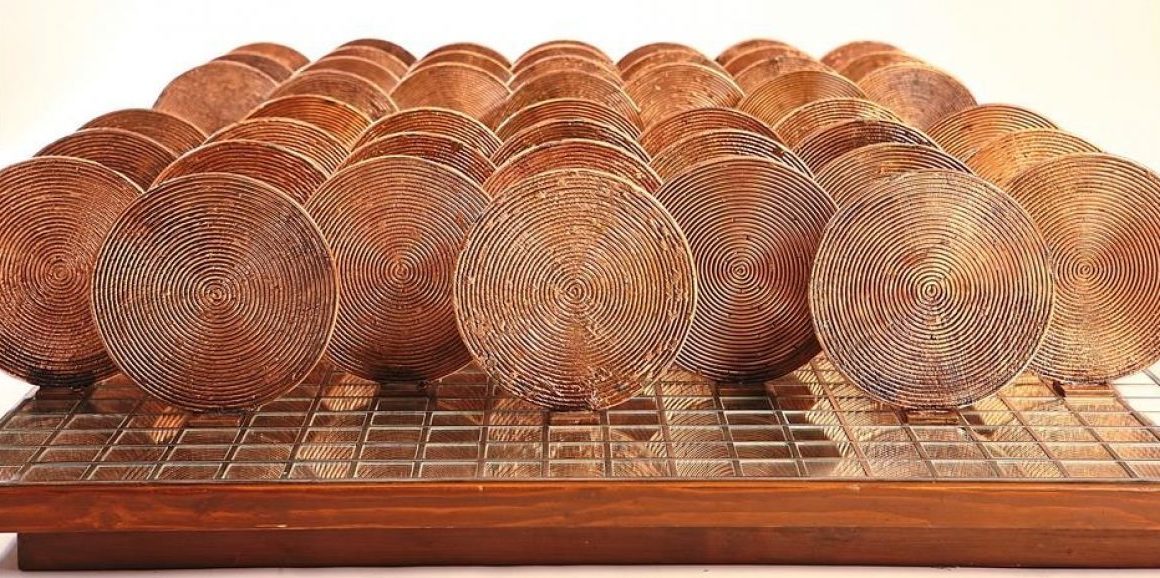Walking On The Moon: Amin Gulgee’s cosmic sculptures
Cosmic Chapati 48: Hunger Game by Amin Gulgee. Photo: Shamyl Khuhro & Jamal Ashiqain
It almost feels like a pilgrimage, a spiritual journey of sorts, ambling through Kuala Lumpur-based gallery Wei-Ling Contemporary, introspectively gazing upon the 25 sculptures of copper and bronze by Amin Gulgee.
The commanding works of the renowned Pakistani sculptor, on display at the gallery till Aug 14, emanate a magnetic otherworldliness.
Each sculpture, painstakingly wrought over the past five years by the 50-year-old, seems to possess its own life and voice, as if they were echoes and whispers from the heavens.
More than that, the voices resonating from the metalwork are of the sculptor’s. Just imagine a meditative chant in the background as you view his new Walking On The Moon exhibition.
“It’s very much my new works in juxtaposition with some older pieces to see how far I’ve come in my journey. That’s the perspective,” says the Karachi-based Amin at a recent interview in Kuala Lumpur.
image: http://cdn.star2.com/wp-content/uploads/2015/07/str2_dkMoon_dineshk_amin.jpg

Pakistani sculptor Amin Gulgee says there is no separation between him and his work. Photo: The Star/Norafifi Ehsan
Wei-Ling Contemporary exhibited Amin’s last exhibition here called Cosmic Mambo in 2011.
image: http://cdn.star2.com/wp-content/uploads/2015/07/str2_dkMoon_dineshk_algorithm-e1436703696609.jpg

Algorithm II by Amin Gulgee. Photo: Shamyl Khuhro & Jamal Ashiqain
His works have toured extensively abroad, including stops in the United States, France, Portugal, Saudi Arabia, Oman and China.
Some art enthusiasts here will also remember his epic solo show Drawing The Line at Galeri Petronas in late 2008.
Amin’s latest exhibition carries a broad range of copper-based works, including horns, calligraphy, architectural design and even the chapati.
This current collection is truly a testament to the sculptor’s unrelenting zeal and passion towards his art.
The artist himself attests to the importance of skill and says he never draws or sketches, as he wants to be “physically, emotionally and intellectually involved in the (creative) process.”
For him, there is no separation between the art and the artist.
“I never want to be removed from it, which is why I have to be at the workshop,” he says.
He adds, cheekily, “The best thing is to get up in the morning and going straight to the workshop. There is no need for a shower because you are going to be covered in grime anyway.”
Amin’s Horn series is a stunning collection of four monumental copper works of water buffalo horns. They, like the great beast of the field, demand respect and reverence.
image: http://cdn.star2.com/wp-content/uploads/2015/07/str2_dkMoon_dineshk_HornSong1-e1436703170752.jpg

Horn Song I by Amin Gulgee. Photo: Shamyl Khuhro Jamal Ashiqain
The horns, imposing in size, could have very well belonged to an ancient temple or a great king for such is their hold.
“The water buffalo is the essence of South Asia. It gives milk, it ploughs the fields and village life runs around this one animal. It is so important. I wanted to highlight that,” reveals Amin, who studied Economics, Architecture and Art History at America’s renowned Yale University.
Moreover, the delicate perforations which Amin had masterfully imbued on the horn sculptures, resemble ceremonial and sacred markings.
In fact, Amin, who opened his own gallery, the Amin Gulgee Gallery in Karachi in 2001, is well known for drawing inspiration from religion.
And it is his three-dimensional calligraphic sculptures which ultimately reflect his prowess as a craftsman. It is interesting to note that Amin’s father, the late Ismail Gulgee, a famous painter and sculptor, was also well known for his calligraphic sculptures. The apple did not fall far from the tree, then.
Amin’s calligraphic pieces in Walking On The Moon are a sight to behold. Upon close inspection, you’ll find that the artist deconstructed verses from scriptures and other ancient texts and rearranged the letters, one on top of another, to the point that they are unrecognisable.
image: http://cdn.star2.com/wp-content/uploads/2015/07/str2_dkMoon_dineshk_birdsnest-e1436703267767.jpg

Ripping The Bird’s Nest by Amin Gulgee. Photo: Shamyl Khuhro Jamal Ashiqain
“You can no longer read the script. They are freed, in a way, of content, although I am very aware of where the content is coming from.
“The letters fly upwards. I want them to be free of the earth and dance upwards towards the sky and moon just be free and have this spirit, energy, joy and celebration,” explains Amin.
Another eye-catching work is called Cosmic Chapati: Unknown Centre. The almost metre-long copper sculpture was done, according to Amin, one wire at a time.
“There’s so much chaos, turmoil, war, evil and horror in this world. This is like my meditation, done one wire at a time and it is all about seeking control and balance,” he says.
Ultimately, Walking On The Moon, is an exhibition that reflects the spiritual and psychological psyche of Amin.
In the exhibition’s catalogue, Amin writes with vibrancy and aptly describes his artistic journey.
“My objects are my dreams, my histories and my myths. My work and my life cannot be separated. In both, I need freedom to swim and dance in deep blue space.”
Walking On The Moon is on at Wei-Ling Contemporary at RT01 6th Floor, The Gardens Mall in Kuala Lumpur till Aug 14. The gallery is open Tuesday to Sunday from 11am to 7pm. For more information, visit weiling-gallery.com, call 03-2260 1106 or 03-22828323 or email [email protected].
Source: star2.com

